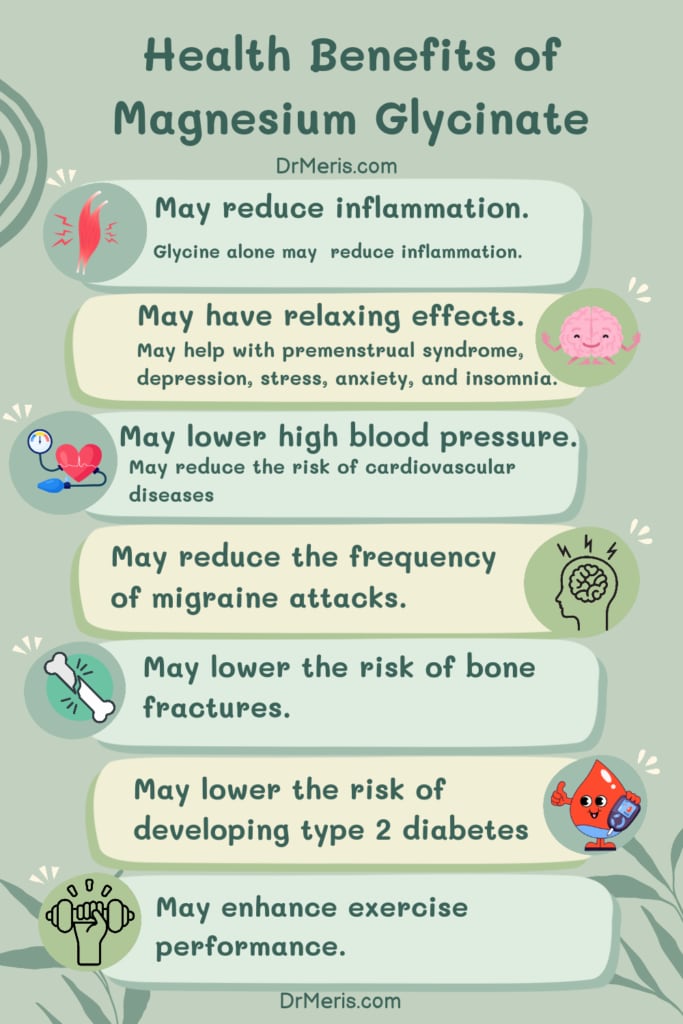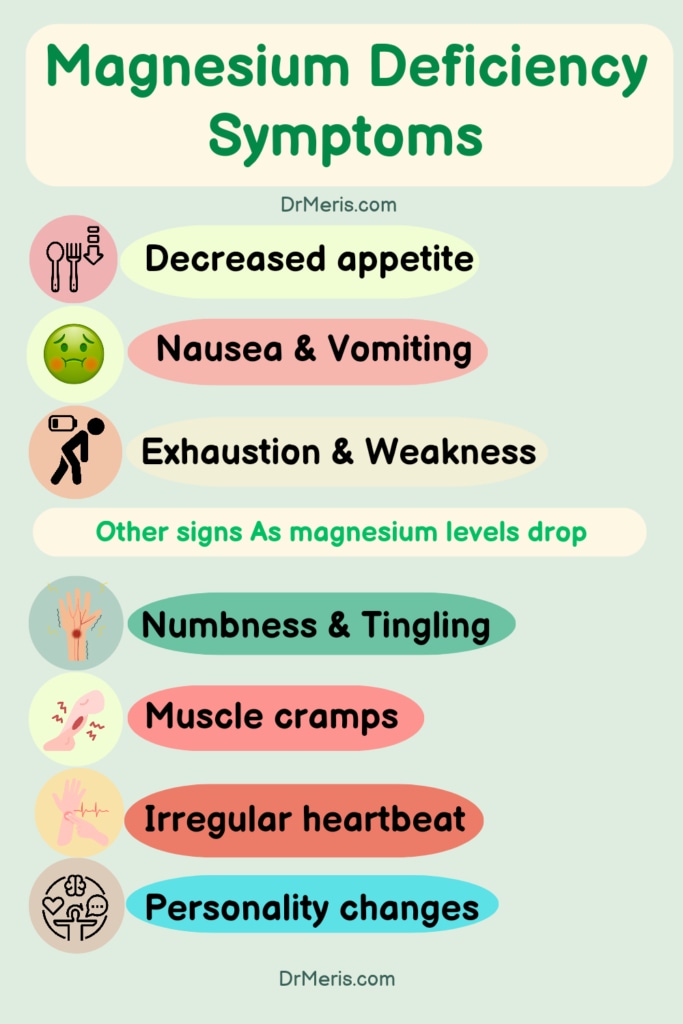Magnesium comes in a variety of forms, including magnesium glycinate, oxide, citrate, and chloride. It is a necessary mineral for our bodies to function. Every form of magnesium has a different set of suggested benefits. Like the majority of other forms, magnesium glycinate can aid in raising blood levels of magnesium, which can help with several health issues, including high blood pressure and migraine headaches.
But why is magnesium glycinate thought to be the best form?
Learn more about this supplement’s possible applications, advantages, and disadvantages by reading this article.
Related article: Magnesium: Benefits, Deficiencies, Sources, Forms, and More.

What is magnesium glycinate?
Magnesium glycinate is a highly bioavailable magnesium form derived from magnesium and the amino acid glycinate.1 Compared to other forms like magnesium oxide and magnesium sulfate, it is less likely to cause gastrointestinal side effects, is well-tolerated, and can be useful for managing low magnesium levels.
What is magnesium chelate?
The type of magnesium that is bound to an amino acid molecule is called magnesium chelate. The chelating agent and magnesium ions form a connection that contributes to the creation of a more stable and absorbable molecule.
This procedure, called chelation, can increase magnesium’s bioavailability, which facilitates its absorption and use by your body.
Nevertheless, magnesium glycinate is only one type of chelated magnesium. Magnesium taurate (magnesium + taurine) and magnesium malate (magnesium + malic acid) are two other varieties. They differ only in terms of amino acids, yet they all share the same fundamental.
Health Benefits of Magnesium Glycinate

May reduce inflammation
Glycine alone may help reduce inflammation and treat a few inflammatory diseases, such as diabetes and heart disease, according to animal research. However, more thorough research is required to corroborate this.2,3
May have relaxing effects
Magnesium glycinate may have relaxing effects. It may lessen mental health problems such as depression, stress, anxiety, and insomnia.4
The “feel-good” hormone in the brain is called serotonin. Serotonin levels appear to be lowered by inadequate magnesium intake. Magnesium may be beneficial for treating mild to moderate depression in adults.5 However, more research is required as there is insufficient scientific data to support these usages.
Another great remedy for women trying to reduce premenstrual syndrome symptoms (PMS) is magnesium glycinate. A thorough review of the literature indicates that magnesium is an empirically supported treatment for PMS.6 According to research, it may function by relaxing the nervous system and normalizing the actions of different hormones (mainly progesterone) on the central nervous system.7
May lower high blood pressure
By marginally lowering blood pressure, magnesium supplements can help with high blood pressure.
Evidence suggests that a magnesium deficit may result in resistance to antihypertensive medication effects.8 Although studies differ in the range of reduction, 500–1000 mg/day of magnesium may lower systolic/diastolic blood pressure as much as 5.6/2.8 mm Hg.9
One study found that magnesium supplementation during pregnancy was associated with lower mean arterial pressure in women, greater birth weight infants, and fewer days spent in the neonatal intensive care unit.10
May reduce the risk of cardiovascular diseases
The results of recent epidemiological research indicate that increased consumption of magnesium, either through diet or supplementation, is linked to a reduction in the risk of major cardiovascular diseases.11
May reduce the frequency of migraine attacks
Low amounts of magnesium can occasionally be found in the blood and tissues of people with migraines. Supplements might assist in lowering the frequency of migraine attacks.12
May lower the risk of bone fractures
Magnesium helps build strong bones. People with higher magnesium levels may have increased bone mineral density. This helps lower the risk of bone fractures caused by osteoporosis.13
May lower the risk of developing type 2 diabetes
Including more magnesium in your diet may lower your risk of developing type 2 diabetes. Magnesium promotes sugar breakdown and may reduce insulin resistance.14
May enhance exercise performance
Magnesium is a vital mineral that is involved in muscular contractions, cardiorespiratory function, and energy metabolism. It has been shown that the general population, including those who engage in physical activity, does not consume enough magnesium.15
Low magnesium levels can affect how well you perform during exercise. Results from research on animals revealed that supplementing with magnesium could enhance energy metabolism efficiency, while research on humans suggested that magnesium supplementation could enhance performance parameters in both aerobic and anaerobic workouts.15
Nevertheless, more thorough research is required in the future, particularly large-scale human intervention studies, to prove the causal association.
What is the difference between magnesium glycinate and magnesium bisglycinate?
Magnesium glycinate and magnesium bisglycinate are frequently used interchangeably in the context of dietary supplements. Both terms pertain to magnesium bonded to the amino acid glycine. They are both well-known for their high absorption and gentle gastrointestinal effects.
The term “biglycinate” indicates that one magnesium molecule and 2 glycine molecules are joined.16 This is comparable to magnesium diglycinate, where the presence of 2 glycine molecules is indicated by the prefix “di-“.17
This structural variation may alter magnesium absorption and bioavailability, however, there is currently insufficient scientific evidence to definitively determine which form is superior.
Glycine is useful when combined with magnesium because it increases the nutrient’s water solubility and bioavailability, increasing its effectiveness.18
What daily amount of magnesium do I need?
How much magnesium you need depends on your age and gender. The average daily recommended amounts, expressed in milligrams (mg), are listed below.19
- Birth to 6 months: 30 mg
- Infants 7–12 months: 75 mg
- Children 1–3 years: 80 mg
- Children 4–8 years: 130 mg
- Children 9–13 years: 240 mg
- Teen boys 14–18 years: 410 mg
- Teen girls 14–18 years: 360 mg
- Men: 400–420 mg
- Women: 310–320 mg
- Pregnant teens: 400 mg
- Pregnant women: 350–360 mg
- Breastfeeding teens: 360 mg
- Breastfeeding women: 310–320 mg
Deficiency

A minor magnesium deficiency might not show any symptoms. The kidneys help retain magnesium in healthy individuals by reducing the amount lost in urine when intake is low.20 Over time, low magnesium consumption may result in deficiency.
Moreover, several medications and medical conditions may make it more difficult for the body to absorb magnesium or increase the amount that is excreted, which could lead to magnesium insufficiency.
Magnesium deficiency symptoms include:20,21
- Decreased appetite
- Nausea
- Vomiting
- Exhaustion
- Weakness
As magnesium levels drop, individuals may also have:
- Numbness
- Tingling
- Seizures
- Muscle cramps
- Irregular heartbeat
- Personality changes
Hypocalcemia refers to low calcium, whereas hypokalemia refers to a potassium deficit. Magnesium facilitates the entry and exit of calcium and potassium ions from cells. It might also aid in the assimilation of these crucial minerals. For this reason, low levels of calcium and potassium might result from a magnesium deficiency.20
Typical causes of inadequate magnesium levels include:
- Age
- Gastrointestinal disorders (such as Crohn’s disease and celiac disease)
- Uncontrolled diabetes and excessive urination
- Alcoholism
- Persistent diarrhea
- Malnourishment,
- Some drugs
What is the normal range for blood magnesium levels?
The normal range for blood magnesium level is 1.7 to 2.2 mg/dL (0.85 to 1.10 mmol/L). Normal value ranges may vary slightly among different laboratories. Some labs use different measurements or test different samples.
Is magnesium testing accurate?
Serum magnesium concentration does not accurately represent the entire magnesium content or intracellular magnesium content of the body because less than 1% of the total magnesium content is found in serum.30
Alternative techniques for assessing magnesium, such as the magnesium loading test, may offer more accurate assessments of the overall magnesium status of the body, enabling better detection of those who are magnesium deficient and preventing consequences associated with magnesium deficiency.30
You can find out if you might be magnesium deficient by trying a supplement and observing your symptoms. Magnesium can be taken both short-term and long-term without risk unless you have chronic kidney disease. While milder forms, such as magnesium glycinate, are generally safe, stronger forms, like magnesium chloride, can induce diarrhea.
What foods provide magnesium?

Magnesium is naturally present in many foods and added to some fortified ones. A range of foods, including the following, can provide you with the needed quantities of magnesium:19-21
- Legumes
- Green leafy vegetables (spinach, kale, collard greens, and mustard greens)
- Nuts, seeds, and whole grains
- Fortified breakfast cereals and other fortified foods.
- Dark chocolate
- Bananas
- Avocados
- Beef, salmon, and poultry.
- Milk, yogurt, and some other milk products.
The table below lists selected magnesium-rich food sources:22
| Food | Milligrams (mg) per serving | Percent DV* |
|---|---|---|
| Pumpkin seeds, roasted, 1 ounce | 156 | 37 |
| Chia seeds, 1 ounce | 111 | 26 |
| Almonds, dry roasted, 1 ounce | 80 | 19 |
| Spinach, boiled, ½ cup | 78 | 19 |
| Cashews, dry roasted, 1 ounce | 74 | 18 |
| Peanuts, oil roasted, ¼ cup | 63 | 15 |
| Cereal, shredded wheat, 2 large biscuits | 61 | 15 |
| Soymilk, plain or vanilla, 1 cup | 61 | 15 |
| Black beans, cooked, ½ cup | 60 | 14 |
| Edamame, shelled, cooked, ½ cup | 50 | 12 |
| Peanut butter, smooth, 2 tablespoons | 49 | 12 |
| Potato, baked with skin, 3.5 ounces | 43 | 10 |
| Rice, brown, cooked, ½ cup | 42 | 10 |
| Yogurt, plain, low fat, 8 ounces | 42 | 10 |
| Breakfast cereals, fortified with 10% of the DV for magnesium, 1 serving | 42 | 10 |
| Oatmeal, instant, 1 packet | 36 | 9 |
| Kidney beans, canned, ½ cup | 35 | 8 |
| Banana, 1 medium | 32 | 8 |
| Salmon, Atlantic, farmed, cooked, 3 ounces | 26 | 6 |
| Milk, 1 cup | 24–27 | 6 |
| Halibut, cooked, 3 ounces | 24 | 6 |
| Raisins, ½ cup | 23 | 5 |
| Bread, whole wheat, 1 slice | 23 | 5 |
| Avocado, cubed, ½ cup | 22 | 5 |
| Chicken breast, roasted, 3 ounces | 22 | 5 |
| Beef, ground, 90% lean, pan broiled, 3 ounces | 20 | 5 |
| Broccoli, chopped and cooked, ½ cup | 12 | 3 |
| Rice, white, cooked, ½ cup | 10 | 2 |
| Apple, 1 medium | 9 | 2 |
| Carrot, raw, 1 medium | 7 | 2 |
*DV represents Daily Value. The United States Food and Drug Administration (FDA) created DVs to assist consumers in comparing the nutritional content of foods and dietary supplements in the context of a whole diet. The DV for magnesium is 420 mg for adults and children aged 4 and up.23
The FDA does not require food labels to include magnesium content unless it has been added to the product. Foods that contain 20% or more of the DV are considered high sources of nutrients, but foods with lower percentages of the DV can also contribute to a healthy diet.
Takeaway
Magnesium is widely present in many foods. The main natural sources are legumes, nuts, greens, whole-grain cereals, and dark chocolate. Other vegetables, fruits, meats, and fish have intermediate magnesium content, while dairy products and beverages have low magnesium content.
How should I use magnesium glycinate supplements?
Supplements containing magnesium glycinate are commonly accessible as pills or powder.
To minimize gastrointestinal disturbance, it is recommended to take magnesium supplements with a meal, unless your doctor or the product’s instructions specify otherwise.
Consult a pharmacist or other healthcare provider if you take any drugs. They can offer you advice on potential interactions between your magnesium supplement and your medicine.
To minimize potential problems, it’s important to consider any other supplements or medications you’re taking. Adults should consume 310-420 mg of magnesium per day, depending on their age and gender.
The following is a list of magnesium daily upper limits from dietary supplements and/or medications.19 The upper limit seems to be lower than the recommended amount for some age groups. This is because they don’t include magnesium which is naturally present in food and drinks.
| Ages | Upper Limit for Magnesium in Dietary Supplements and Medications |
|---|---|
| Birth to 12 months | Not established |
| Children 1–3 years | 65 mg |
| Children 4–8 years | 110 mg |
| Children 9–18 years | 350 mg |
| Adults | 350 mg |
Can I skip a day of magnesium?
There is no need to be concerned if you skip taking your magnesium supplement for one or more days because it takes time for your body to become severely magnesium deficient. However, if an underlying health problem is creating low magnesium levels, a doctor may advise taking specific doses daily to replenish magnesium levels.
How fast does magnesium glycinate work?
Magnesium taken in pill form typically takes a week to show any impact, though this can be longer. If you want to treat a deficiency or enhance a disease, consuming magnesium capsules or pills for at least four weeks is the most effective strategy to ensure results.
Are magnesium glycinate supplements safe?
Magnesium supplements, such as magnesium glycinate, are deemed safe when used at the recommended dosages. Magnesium glycinate supplements, when used properly, have no notable negative effects and are safe for most people, including pregnant and breastfeeding women. They are also safe for children and adolescents.24
However, consuming too much magnesium from dietary supplements might cause serious side effects, so stick to the recommended doses.
What happens if I consume too much magnesium?
Naturally occurring magnesium in food and drink does not pose a risk and does not require restriction. The kidneys of healthy individuals can eliminate the excess in urine.25 But unless a doctor advises otherwise, magnesium in dietary supplements and prescription drugs shouldn’t be used over the upper limit.
On the other hand, excessive magnesium intake from dietary supplements or medications frequently causes diarrhea, which may also be accompanied by nausea and cramping in the abdomen.19 The forms of magnesium that are most frequently associated with diarrhea are magnesium oxide, gluconate, carbonate, and chloride.26
Magnesium toxicity has been linked to extremely high dosages of magnesium-containing laxatives and antacids (usually more than 5,000 mg magnesium per day).27
Magnesium toxicity symptoms typically appear after serum concentrations exceed 1.74-2.61 mmol/L and include:25
- Hypotension
- Nausea
- Vomiting
- Facial flushing
- Urine retention
- Ileus (a short-term condition in which your gut is unable to remove food and waste from your body)
- Depression
- Lethargy before progressing to muscle weakness
- Difficulty breathing
- Severe hypotension
- Irregular heartbeat
- Cardiac arrest
The risk of magnesium poisoning rises with poor renal function or kidney failure because the ability to eliminate excess magnesium is reduced or lost.19,25
Does magnesium interact with medications or other dietary supplements?
Magnesium supplements can interact with some medications. Here are a few examples:
- Antibiotics may not be absorbed if taken just before or after magnesium-containing dietary supplements.28
- Bisphosphonates, which are used to treat osteoporosis, are poorly absorbed when taken immediately before or after magnesium-rich dietary supplements or drugs.29
- Diuretics and proton-pump inhibitors may cause magnesium loss and hypomagnesemia (magnesium deficiency).28
- High amounts of zinc supplements might disrupt the body’s magnesium absorption and regulation.28
Inform your doctor, pharmacist, and other healthcare providers about any dietary supplements, prescription, or over-the-counter medications you use. They can inform you whether the dietary supplements will interact with your medications or whether the medications will interfere with how your body absorbs, uses, or breaks down nutrients.
Final Thoughts
Magnesium glycinate is a highly bioavailable form of magnesium that’s well-tolerated and unlikely to cause gastrointestinal side effects when taken in normal doses. It may provide health benefits such as anxiety relief, bone health, blood sugar management, and PMS symptom reduction, among others.
Just keep in mind that although supplements can be very beneficial, a balanced diet, frequent exercise, and adequate sleep are all important components of a healthy lifestyle.
As usual, it’s a good idea to see a healthcare provider to make sure starting any new supplement is the appropriate decision for you.
References
1. National Center for Biotechnology Information (2024). PubChem Compound Summary for CID 84645, Magnesium glycinate. Retrieved May 24, 2024 from https://pubchem.ncbi.nlm.nih.gov/compound/Magnesium-glycinate.
2. Razak, M. A., Begum, P. S., Viswanath, B., & Rajagopal, S. (2017). Multifarious Beneficial Effect of Nonessential Amino Acid, Glycine: A Review. Oxidative medicine and cellular longevity, 2017, 1716701. https://doi.org/10.1155/2017/1716701
3. Kawai, N., Sakai, N., Okuro, M., Karakawa, S., Tsuneyoshi, Y., Kawasaki, N., Takeda, T., Bannai, M., & Nishino, S. (2015). The sleep-promoting and hypothermic effects of glycine are mediated by NMDA receptors in the suprachiasmatic nucleus. Neuropsychopharmacology : official publication of the American College of Neuropsychopharmacology, 40(6), 1405–1416. https://doi.org/10.1038/npp.2014.326
4. Yablon LA, Mauskop A. Magnesium in headache. In: Vink R, Nechifor M, editors. Magnesium in the Central Nervous System [Internet]. Adelaide (AU): University of Adelaide Press; 2011. Available from: https://www.ncbi.nlm.nih.gov/books/NBK507271/
5. Tarleton, E. K., Littenberg, B., MacLean, C. D., Kennedy, A. G., & Daley, C. (2017). Role of magnesium supplementation in the treatment of depression: A randomized clinical trial. PloS one, 12(6), e0180067. https://doi.org/10.1371/journal.pone.0180067
6. Parazzini, F., Di Martino, M., & Pellegrino, P. (2017). Magnesium in the gynecological practice: a literature review. Magnesium in the gynecological practice: a literature review. Magnesium research, 30(1), 1–7. https://doi.org/10.1684/mrh.2017.0419
7. Quaranta, S., Buscaglia, M. A., Meroni, M. G., Colombo, E., & Cella, S. (2007). Pilot study of the efficacy and safety of a modified-release magnesium 250 mg tablet (Sincromag) for the treatment of premenstrual syndrome. Clinical drug investigation, 27(1), 51–58. https://doi.org/10.2165/00044011-200727010-00004
8. Rudnicki, M., Frölich, A., Rasmussen, W. F., & McNair, P. (1991). The effect of magnesium on maternal blood pressure in pregnancy-induced hypertension. A randomized double-blind placebo-controlled trial. Acta obstetricia et gynecologica Scandinavica, 70(6), 445–450. https://doi.org/10.3109/00016349109007158
9. Ryan, M. P., & Brady, H. R. (1984). The role of magnesium in the prevention and control of hypertension. Annals of clinical research, 16 Suppl 43, 81–88.
10. Houston M. (2011). The role of magnesium in hypertension and cardiovascular disease. Journal of clinical hypertension (Greenwich, Conn.), 13(11), 843–847. https://doi.org/10.1111/j.1751-7176.2011.00538.x
11. Rosique-Esteban, N., Guasch-Ferré, M., Hernández-Alonso, P., & Salas-Salvadó, J. (2018). Dietary Magnesium and Cardiovascular Disease: A Review with Emphasis in Epidemiological Studies. Nutrients, 10(2), 168. https://doi.org/10.3390/nu10020168
12. Mauskop, A., & Varughese, J. (2012). Why all migraine patients should be treated with magnesium. Journal of neural transmission (Vienna, Austria : 1996), 119(5), 575–579. https://doi.org/10.1007/s00702-012-0790-2
13. Rondanelli, M., Faliva, M. A., Tartara, A., Gasparri, C., Perna, S., Infantino, V., Riva, A., Petrangolini, G., & Peroni, G. (2021). An update on magnesium and bone health. Biometals : an international journal on the role of metal ions in biology, biochemistry, and medicine, 34(4), 715–736. https://doi.org/10.1007/s10534-021-00305-0
14. Fang, X., Han, H., Li, M., Liang, C., Fan, Z., Aaseth, J., He, J., Montgomery, S., & Cao, Y. (2016). Dose-Response Relationship between Dietary Magnesium Intake and Risk of Type 2 Diabetes Mellitus: A Systematic Review and Meta-Regression Analysis of Prospective Cohort Studies. Nutrients, 8(11), 739. https://doi.org/10.3390/nu8110739
15. Chen, H. Y., Cheng, F. C., Pan, H. C., Hsu, J. C., & Wang, M. F. (2014). Magnesium enhances exercise performance via increasing glucose availability in the blood, muscle, and brain during exercise. PloS one, 9(1), e85486. https://doi.org/10.1371/journal.pone.0085486
16. National Center for Biotechnology Information (2024). PubChem Compound Summary for CID 75487596, Magnesium bisglycinate. Retrieved May 25, 2024 from https://pubchem.ncbi.nlm.nih.gov/compound/Magnesium-bisglycinate.
17. Schuette, S. A., Lashner, B. A., & Janghorbani, M. (1994). Bioavailability of magnesium diglycinate vs magnesium oxide in patients with ileal resection. JPEN. Journal of parenteral and enteral nutrition, 18(5), 430–435. https://doi.org/10.1177/0148607194018005430
18. Case, D. R., Zubieta, J., Gonzalez, R., & Doyle, R. P. (2021). Synthesis and Chemical and Biological Evaluation of a Glycine Tripeptide Chelate of Magnesium. Molecules (Basel, Switzerland), 26(9), 2419. https://doi.org/10.3390/molecules26092419
19. Institute of Medicine (IOM). Food and Nutrition Board. Dietary Reference Intakes: Calcium, Phosphorus, Magnesium, Vitamin D and Fluoride. Washington, DC: National Academy Press, 1997.
20. Rude RK. Magnesium. In: Ross AC, Caballero B, Cousins RJ, Tucker KL, Ziegler TR, eds. Modern Nutrition in Health and Disease. 11th ed. Baltimore, Mass: Lippincott Williams & Wilkins; 2012:159-75.
21. Rude RK. Magnesium. In: Coates PM, Betz JM, Blackman MR, Cragg GM, Levine M, Moss J, White JD, eds. Encyclopedia of Dietary Supplements. 2nd ed. New York, NY: Informa Healthcare; 2010:527-37.
22. U.S. Department of Agriculture, Agricultural Research Service. FoodData Central, 2024.
23. U.S. Food and Drug Administration. Food Labeling: Revision of the Nutrition and Supplement Facts Labels. 2016.
24. National Institutes of Health. Magnesium.
25. Musso C. G. (2009). Magnesium metabolism in health and disease. International urology and nephrology, 41(2), 357–362. https://doi.org/10.1007/s11255-009-9548-7
26. Ranade, V. V., & Somberg, J. C. (2001). Bioavailability and pharmacokinetics of magnesium after administration of magnesium salts to humans. American journal of therapeutics, 8(5), 345–357. https://doi.org/10.1097/00045391-200109000-00008
27. Kutsal, E., Aydemir, C., Eldes, N., Demirel, F., Polat, R., Taspnar, O., & Kulah, E. (2007). Severe hypermagnesemia as a result of excessive cathartic ingestion in a child without renal failure. Pediatric emergency care, 23(8), 570–572. https://doi.org/10.1097/PEC.0b013e31812eef1c
28. Gröber U. (2019). Magnesium and Drugs. International journal of molecular sciences, 20(9), 2094. https://doi.org/10.3390/ijms20092094
29. Ricchiuto, S., Palumbo, R., Lami, F., Gavioli, F., Caselli, L., Montanari, M., Zappavigna, V., Anesi, A., Zanocco-Marani, T., & Grande, A. (2023). The Capacity of Magnesium to Induce Osteoclast Differentiation Is Greatly Enhanced by the Presence of Zoledronate. Biology, 12(10), 1297. https://doi.org/10.3390/biology12101297
30. Razzaque M. S. (2018). Magnesium: Are We Consuming Enough?. Nutrients, 10(12), 1863. https://doi.org/10.3390/nu10121863
Sign Up for Our Email List
Get our latest articles, healthy recipes, tips, and exclusive deals delivered straight to your inbox with our newsletter.
We won't send you spam. Unsubscribe at any time.








